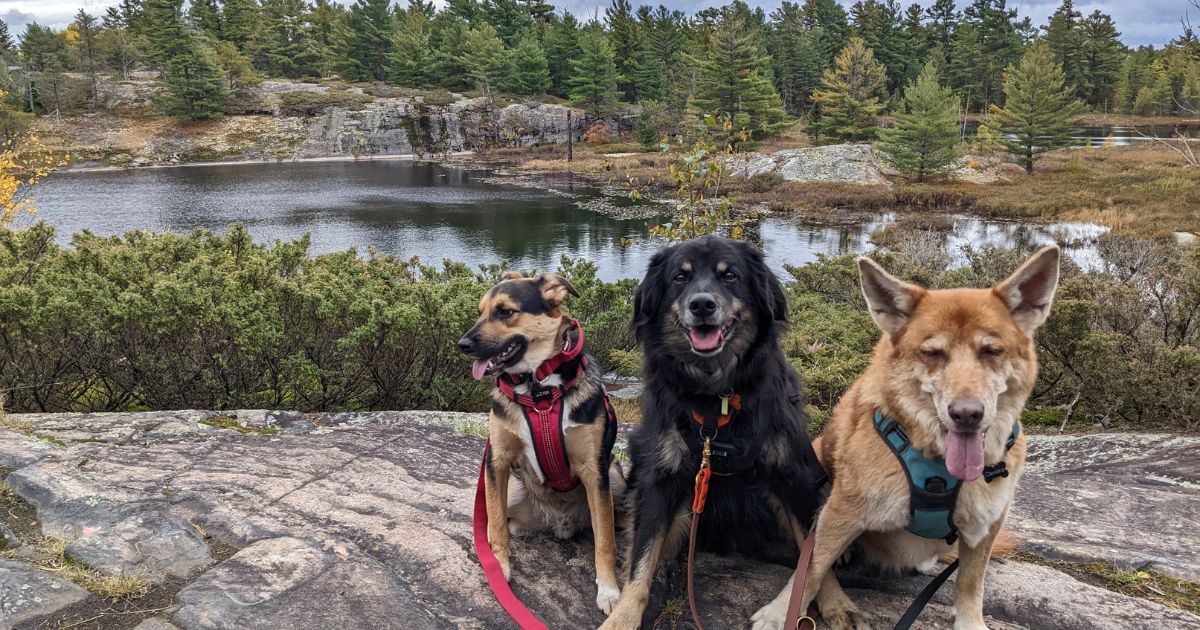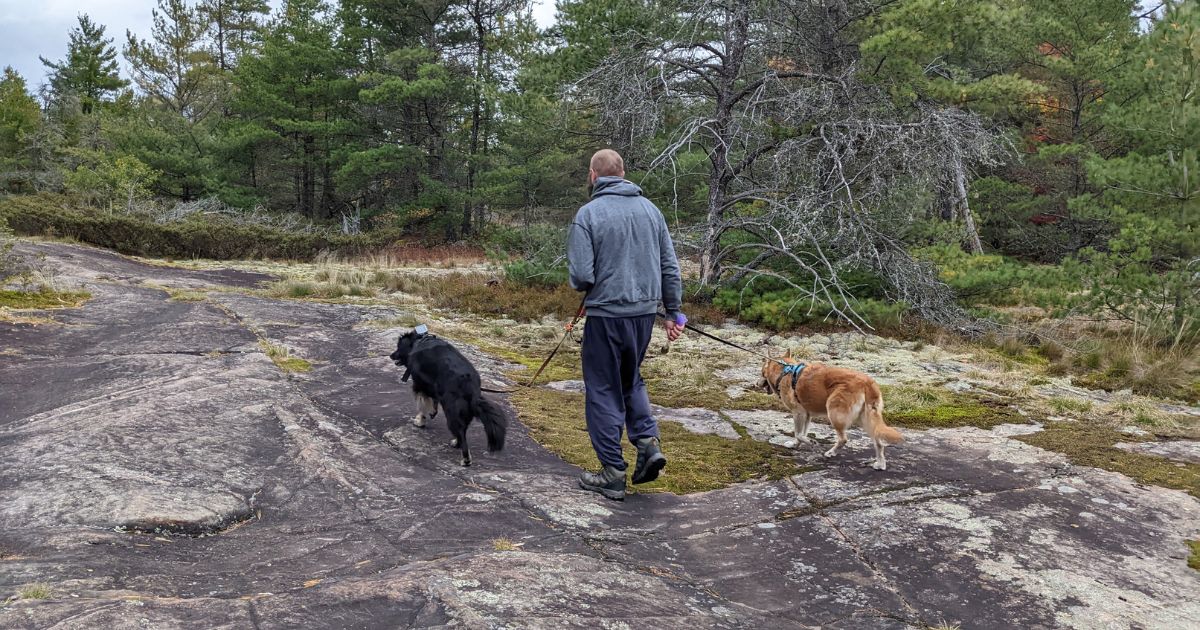10 Rules of Hiking with Pets Responsibly
Hiking is a great way to get out and enjoy the beauty of the great outdoors. It’s a great way to be active and build a lasting bond with our pets.
But, as with any activity, there are rules and guidelines to ensure everyone has a safe and enjoyable experience. Hiking with cats and dogs is no exception.
Whether you are new to hiking or looking to brush up on your trail etiquette, here are 10 rules of hiking with your dog or cat that you should be familiar with.

What is the Meaning of the Saying “Hike Your Own Hike”
A popular saying among the outdoor travel community, the “hike your own hike” meaning is quite simple – find out what works for you on the trail, apply that to your adventures, and don’t dictate how others approach outdoor travel.
It’s a concept we support in many ways, but it doesn’t always apply.
While we encourage all of you to find what works for you when hiking with dogs or cats, there are some basic rules for hiking to consider. This includes both hiking etiquette and general trail rules.
We believe you should “hike your own hike” until such time that your decisions:
- Risk your safety, the safety of your pets, or the safety of other hikers
- Ruins the experience of others on the trail
- Damages local wildlife, plant life, or other aspects of the ecosystem
With those stipulations in mind, we put together this list. Below are x rules to consider when preparing for your next outdoor adventure.
10 Rules for Hiking with Dogs and Cats
Check that the Trail is Pet-Friendly
Before heading out on your next hiking adventure with your furry companion by your side, make sure pets are allowed on the trail.
One easy way to check this is to look up the trail you are considering on the AllTrails app.
Obey Leash Rules and Posted Signage
Pay attention to the leash rules for each location you visit, specifically where your dog is permitted to be off-leash and where leashes are required.
Additionally, pay attention to the details of the rules, like whether there is a maximum leash length.
Leash rules aren’t in place to penalize you and your pets. They are created to keep everyone safe and allow all adventurers to enjoy the trails. This includes those who are afraid of dogs, people hiking with reactive dogs, or outdoor travellers hiking with cats.
In each of the examples I listed, the outdoor adventurers likely chose a trail, specifically knowing it was an on-leash location to prevent a dangerous or uncomfortable situation.
If you are looking to enjoy an off-leash adventure, take the time to seek out a designated off-leash trail, crownland, or private property.
Know Your Pet and Their Limitations
One of the most overlooked rules of hiking with pets is knowing YOUR pet and their unique limitations. After all, no two pets are identical. This means knowing the following:
- Your pet’s confidence and comfort level when on the trail
- Any triggers that could cause stress or anxiety
- How often they need to take breaks to complete the hike safely
- Their level of obedience and training
For example, an off-leash hiking trail is great, BUT if your dog isn’t confident in their recall, you are setting them up to fail. This could mean putting your dog in danger. Instead, work on recall training at home and stick to on-leash adventures until they are ready.
Another example would be a cat that is nervous around dogs or larger groups of people. Recognizing this allows you to plan appropriately and seek a quieter, less popular trail.
Finally, make sure you pay attention to your pet’s body language. Even a skilled and experienced hiking dog or cat may have an “off” day. Know when an extra break is needed, and don’t be afraid to cut a trip short if it’s in everyone’s best interests.
Ensure Your Pet is Always Under Control
Even when using a leash, you must ensure that you manage your pet appropriately. This means giving them your full attention and addressing their behaviour, if necessary.
While it doesn’t necessarily fall under the rules of hiking, we recommend leaving the headphones at home when heading out with your pet by your side. By eliminating this distraction, you can focus on what your pet is doing and any potential triggers or dangers ahead.
This means calling your dog to your side or shortening the leash when approaching others, including hikers, their pets, or local wildlife.
Cats, for example, may not be a great threat in the eyes of other hikers. But they can cause severe damage to smaller wildlife if they are allowed to approach or chase them.
Respect the Designated Trail
Trails are generally created in such a way that they allow you to enjoy the sights while causing as little disruption to the environment as possible. But for this to work, we all need to stick to the trails.
This includes keeping your pet on the trails and not allowing them to wander off into the bush.
Going off trail risks damaging the vegetation in the area. This can have a lasting impact on the greater ecosystem, especially if others are doing the same.
Studies have shown that hiking boots (or your pet’s paws) can also act as a source of transmission and contamination – meaning that they can pick up contaminated soil, seeds, or bugs, carrying these invasive species to other areas.
In addition to staying on the trail, you can help to reduce this risk by brushing your hiking boots before each hike and wiping down your pet’s paws before and after each hike.

Be Aware of Local Wildlife
When hiking with cats and dogs, you must always be aware of the wildlife in the area. This includes not only wildlife that they could harm (as mentioned above) but also potential predators.
Depending on where you are hiking, some examples of predators you may encounter include:
- Bears
- Wolves
- Cougar
- Venomous snakes
We have previously discussed the importance of bear safety when camping. But we must also be bear-safe (or predator safe) when hitting the trails.
One simple proactive measure you can take is to make it known that you are there. This doesn’t mean you have to scream and shout, disturbing all other hikers in the area. But you can make noise that will alert nearby wildlife by talking to your dogs or wearing bear bells.
We also recommend carrying bear spray if you are hiking in a high-risk area.
Yield Right of Way to Other Hikers
As a general rule, hikers on the trails with their pets should yield the right-of-way to those hiking pet-free. This includes hikers, trail runners, bikers, and horseback riders.
When you see someone approaching, step to the side of the trail with your pet.
If your pet is small enough, simply pick them up to keep them out of the way. For larger dogs, have your dog move to the side of the trail and wait patiently (and calmly). One way to do this effectively is to place your dog in a sit/stay until the other trail users pass.
For pets unfamiliar or uncomfortable with bikes or horses, which is surprisingly common, be sure to place yourself between your pet and the other trail user to create a feeling of safety.
What is the rule regarding the right-of-way when both hikers (or groups) have pets? At this point, you would return to basic trail etiquette rules.
- Hikers travelling uphill have the right-of-way
- Uphill hikers may choose to take a break and yield to downhill hikers, but only when they choose to do so
- Announce your presence when coming up behind other hikers
- Always share the trail by staying to one side and allowing room for others
Always Clean Up After Your Pet
I don’t know about you, but when I head out on the trails, I look forward to enjoying the natural beauty, not the trash left behind by other hikers. This includes your dog’s waste.
Carry biodegradable dog poop bags to pick up and pack out any waste during your hike.
- Do NOT leave bags of dog poop behind to “pick up on the way out.” While this may seem like a good idea, it means leaving that eyesore for other hikers in the meantime.
- Do NOT kick dog poop off the trail into the bush. Our domesticated dogs’ diet differs from that of the local wildlife and can seriously disrupt the local ecosystem.
You can purchase dog poop holders that clip onto your leash, hiking belt, or backpack to carry the used waste bags so that you don’t have to hold them for the rest of your hike.
Have a Pet-Focused Emergency Plan
Anytime that you head out on the trails, you should have an emergency plan in place. This means knowing what you will do in the event of an accident or injury.
But there are some unique considerations when preparing for hiking with your dog or cat.
Are you prepared to evacuate your pet if something were to happen? Securing your cat or small dog in a backpack is relatively easy, but what about those of us who hike with larger dogs?
What if you are the one injured? Do you have a plan if you are unable to hike your dog out?
Anytime we head out onto the trails, John and I each wear a hands-free hiking belt. If necessary, we could hook all three dogs to one of us if the other person is injured and can’t manage a dog themselves.
Don’t forget to consider any training necessary for hiking in these conditions. For example, we had to train our dogs to all hike on hands-free leashes. Three dogs could easily pull a hiker down the trail if their leash manners weren’t solid.
Other emergency items you may want to add to your hiking list include a pet-friendly first aid kit and an emergency harness for carrying larger dogs.
Make Lasting Memories Together
Of course, the most important rule when heading out on the trails with your pet is to enjoy that time together.
This may mean letting go of your expectations or adjusting to accommodate your pet’s needs. For example, our curious adventure cat Pippen LOVES being “paws on the trail,” but she moves a lot slower than we would with her in the backpack.
Allow yourself to be in the moment, enjoy your time together, and build an even stronger bond. These special moments will create memories that will last a lifetime.

Final Thoughts: Rules of Hiking with Pets
If you are heading out hiking with dogs and cats, good news. You can avoid many harmful or dangerous situations with some planning.
Choose a pet-friendly trail that is suited to both your needs and that of your pet, including trail difficulty, the expected traffic level, on-leash vs off-leash, and any other important considerations.
Additionally, ensure you pack all the gear necessary for a safe trip. This includes plenty of fresh water for you and your pet, a pet-friendly first aid kit, and an emergency harness if you are hiking with a larger dog.
By paying attention to the above rules of hiking with dogs and cats, you will set yourself up for a safe and enjoyable adventure for everyone!

Are there any rules you weren’t familiar with? Did I miss any rules that you believe should be on the list? Share your thoughts in the comment section!
